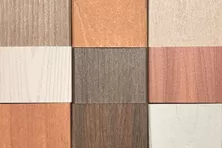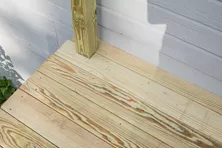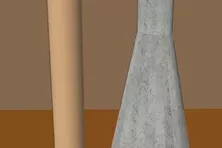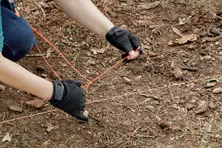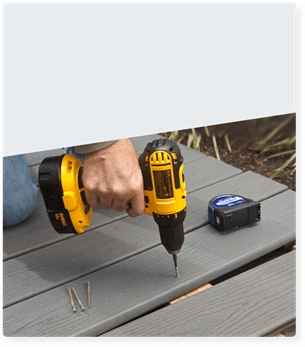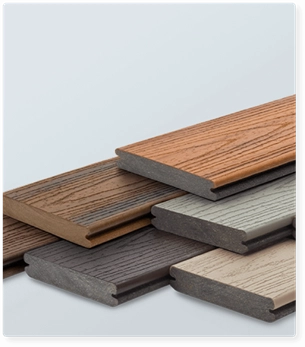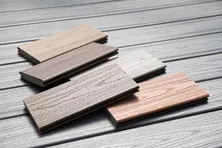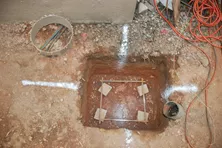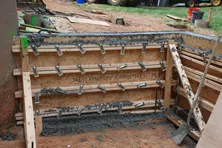Cedar Decking: Prices, Different Types, Maintenance & More
Cedar is a fantastic choice for a deck building material because of its combination of unique properties. It is dimensionally stable, meaning that it lays flat and stays straight. Even grain and consistent density make it less likely to warp, cup or twist. It’s fragrant, dark-colored heartwood naturally resists rot and insect infestation in outdoor environments without the need for preservative chemicals. It has a rich, warm aesthetic offering a range of natural hues, tight grain patterns and soft textures. Fresh cut cedar will come in a wide range of honey/peach shades of light brown. When exposed to weather, it will change in color to silver gray. Cedar’s softness makes it easy to work with and readily accepts protective stains, although its sawdust can be irritating to the skin and lungs. Its thermal properties allow it to stay cool to the touch in summer heat. The price and availability for different types of cedar wood will vary from region to region. It should be more available and less expensive than redwood and composite decking. We recommend protecting cedar by staining.
Cedar is similar to redwood in many of its properties because both are from the same genus. Cedar, however, has more flexural toughness than redwood, meaning that it can flex more without shattering and is also less dense and has less natural oil that make it easier to accept stain. Cedar forests are also more abundant and present somewhat less of an environmental issue for commercial logging, if managed responsibly.
Cedar trees have a long history in the forestry industry and have been studied by scientists for over a century. The trees grow principally in the Pacific Northwest forests; many reach heights of up to 200 feet tall. These forests are precious resources that require centuries to mature and thrive. Most Old Growth Cedar forests have been restricted or closed to logging to protect the unique ecosystem from exploitation. Old Growth Cedar has higher density than Second Growth but, because it is not primarily used for its structural properties, it usually makes little difference. Managed forestry is the environmentally and socially responsible practice of logging and manufacturing lumber to maintain the sustainability of our forests. Be sure that any cedar you buy includes a FCS product label to ensure that it was responsibly harvested and can be traced by its chain of custody. The Forest Stewardship Council (FSC) www.fsc.org is an international non-profit organization whose mission is to promote environmentally appropriate, socially beneficial and economically viable management of the world’s forests.
Types Of Cedar
Many types of cedar wood are only available in a limited and regional capacity. Your range of choices will likely be determined by the region you live in. Western Red Cedar is the most widely available cedar type across the U.S. Unless you live in the region where other types of cedar are harvested and milled, it may be difficult to find a source. Check with your local lumberyards to see what they can offer you.
Western Red Cedar – The most common type of cedar you are likely to find at your local lumberyard. Western Red Cedar is more rot-resistant than eastern varieties. It also comes from a significantly larger tree so it can yield a larger variety of dimensional lumber. It is native to the Pacific Northwest. Western Red Cedar is moderately soft and lightweight, and its heartwood is extremely decay-resistant and exhibits little shrinkage. The wood is generally straight-grained and has a uniform, but rather coarse texture. The heartwood of Western Red Cedar is fragrant reddish or pinkish brown to dull brown and the sapwood is nearly white.
Eastern White Cedar – Not nearly as common to find in most parts of the United States as WRC. It is also somewhat less desirable than its larger cousin. These trees are native to eastern Canada and the north central and eastern parts of the United States. Most of the large trees were harvested in the late 1800s. It is lightweight, moderately soft and naturally resistant to rot and insect infestation. The heartwood of eastern white pine is a light brown, sometimes with a reddish tinge, turning darker on exposure. The sapwood is white, tinged with yellow. It has a uniform texture, is easily worked with tools, shrinks little, is straight-grained and has a high nail holding ability to stay in place. It has medium strength values and accepts stains, glue and finishes well.
Atlantic Cedar - Atlantic White Cedar is native to the Coastal Plain of the eastern U.S. The wood has a characteristic aromatic odor when freshly cut and has a faint bitter taste. The sapwood of Atlantic White Cedar is narrow and white, while the heartwood is light brown with a reddish or pinkish tinge. It is lightweight and has a fine texture and a straight grain. It is moderately soft, low in shock resistance and is weak in bending and endwise compression. It is very resistant to decay, works easily with tools, shrinks little, finishes smoothly, holds paint well and splits easily.
Incense Cedar – These trees can reach ages up to 500 years old. Incense Cedar is native to the mountains from western Oregon to southern California and the northern Baja Peninsula of Mexico. The sapwood of Incense Cedar is a creamy white, while the heartwood is light brown to light reddish brown. The heartwood has an aromatic, spicy odor, and is highly resistant to decay, even in the wettest of conditions. It holds paint extremely well, has an unusually straight grain, and has high-dimensional stability. It also works well in structures that are subjected to considerable temperature fluctuations. It works well with hand tools and machines, forming smooth surfaces. It glues and nails well, but blunt nails should be used to avoid splintering the wood. It is rated as moderately-low to low in strength, shock resistance, stiffness and hardness.
Northern White Cedar – Native to eastern Canada and the north, central and eastern parts of the U.S. It has an even grain, fine texture, and the lowest density of any commercial domestic wood. Because of this, it is often also used for building canoes. It is soft and has low mechanical properties (bending and compressive strength, hardness, stiffness, shock and splitting resistance and nail and screw holding ability). The sapwood of Northern White Cedar is thin and white, while the heartwood is a light brown. The wood has an aromatic spicy ‘cedary or pencil-like’ odor. The heartwood is resistant to decay and subterranean termites. It is easy to work with hand tools. It is dimensionally-stable and holds paint well.
Port Orford Cedar - Port Orford Cedar is native to a narrow zone near the Pacific Coast from southwest Oregon to northwest California. The sapwood of Port Orford Cedar varies from nearly white to a pale yellowish brown and is 1 to 3 inches wide. The heartwood is yellowish white to pale yellowish brown. It weathers to a light gray, with a silvery sheen, without checks. The wood has a fine, even texture and the grain is even and straight. It has a characteristic odor described as "gingerlike" and a bitter, spicy taste. It is moderately light in weight and is stiff, strong, hard and somewhat shock-resistant. It shrinks slightly when dried, with little tendency to warp. It works well with tools and holds paint and polishes well. The heartwood is highly resistant to decay. It has been used for mine timbers and to make match sticks.
Southern Red Cedar - Southern Red Cedar is native to the Coastal Plain of the eastern United States, from northeast North Carolina south to central Florida and west to southeast Texas. The heartwood of southern Red Cedar is a dull red. The wood is straight-grained, lightweight, soft and weak. It works and finishes well. It is extremely aromatic and repels insects.
Grading Cedar
Cedar is graded similarly to other western woods, but its use is generally more concerned with appearance than structural strength. Most cedar lumber will be stamped with species and graded. Some high-quality grades may not be stamped to prevent the wood from being defaced. You may run into some cedar grades at lumberyards that you may be unfamiliar with. Less technical grades are more subjective and are usually related only to appearance. We refer to these as vernacular or colloquial-graded wood. The same lumber grades can vary between mills and from batch to batch. The best policy is to personally examine the wood before you buy it unless you are familiar and trust a specific lumberyard.
Trim Boards Knotty Grades Unseasoned or Seasoned
Select Tight Knot Grade or Number 2 - This grade has very few defects and some sapwood. Any knots present are sound encased and tight. It is generally regarded as a high-quality choice for cedar.
Number 2 - Has more knots and sapwood. Number 2 will be less expensive than Select. This will be the bare minimum grade you will want to use on a deck.
WRCLA Decking Grades
WRCLA Architect Clear - This is an exclusive high-end product exhibiting the highest standards of manufacture and quality control. It is the most expensive and is usually manufactured to each individual order.
WRCLA Custom Clear - Finely-machined surface will show some limited characteristic defects.
WRCLA Architect Knotty - Tight Knotted Decking. It is generally straight.
WRCLA Custom Knotty - Hole free, more and larger knots than Architect Knotty. This is the least expensive choice for cedar decking.
Capped Composite Decking
What is capped composite decking? It's a great option if you like the look of wood but not the maintenance. Learn about capped composite at Decks.com.
Endeck
Endeck PVC decking is manufactured by Enduris Extrusions in Jacksonville, FL.
Bark Side Up vs. Best Side Up
Unsure which way to lay your decking boards? Check out our guide to learn if your deck boards should lay bark side up or bark side down at Decks.com.
Cutting a Concrete Pad
Learn how to use a concrete saw to cut a hole in a patio slab to install a deck footing.
Monolithic Pier
Compare the pros and cons of installing a solid concrete deck footing using a cardboard tube or engineered forms.
Layout Deck Foundations
Learn how to lay out your deck footings accurately using triangulation with our step-by-step instructions.
More Helpful Resources
Explore Articles by Topic

Footings
Information related to installing frost footings for decks

Framing
Learn structural framing methods

Decking
Learn about wood and composite decking materials

Stairs
An in-depth look at the complex issue of how to build stairs

Railings
How to install guardrails and handrails to meet IRC code

Features
An overview on water drainage, benches, planters and lights

Design
The basics of deck design

Planning
Learn about permits and working with contractors

Porches & Patios
Build a covered deck to enjoy all seasons

Ledger
Proper attachment techniques

Care
Maintain your deck to maintain your investment

Materials
An overview on water drainage, benches, planters and lights
Is Trex Decking Worth the Investment? Expert Insights and Reviews
Discover why Trex decking is worth the investment. Learn about its durability, low maintenance, eco-friendliness, and the long-term value it adds to your home.
Comparing Trex Decking Lines: Signature vs Lineage vs Transcend vs Select vs Enhance
Discover the four main types of Trex decking: Transcend Lineage, Transcend, Select, and Enhance. Check out our review to learn what sets each apart.
Endeck
Endeck PVC decking is manufactured by Enduris Extrusions in Jacksonville, FL.
How many footings do I need?
Learn how to determine the number of footings and support posts you need for your deck when designing your deck frame.
Soil Conditions
Learn how soil conditions can affect the size of your deck footings. Do you have gravel, sand or clay soil?
Retaining Walls
Avoid problems related to digging deck footings near retaining walls. Learn some tips from the pros for how to handle these difficult situations.
Explore Articles by Topic

Footings
Information related to installing frost footings for decks

Framing
Learn structural framing methods

Decking
Learn about wood and composite decking materials

Stairs
An in-depth look at the complex issue of how to build stairs

Railings
How to install guardrails and handrails to meet IRC code

Features
An overview on water drainage, benches, planters and lights

Design
The basics of deck design

Planning
Learn about permits and working with contractors

Porches & Patios
Build a covered deck to enjoy all seasons

Ledger
Proper attachment techniques

Care
Maintain your deck to maintain your investment

Materials
An overview on water drainage, benches, planters and lights





